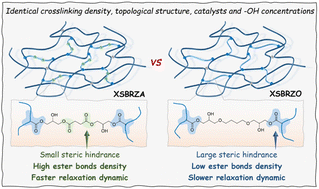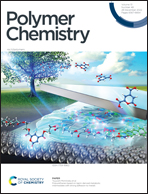Design of ester crosslinked rubber with high dynamic properties by increasing dynamic covalent bond density†
Abstract
Dynamic covalent bonds (DCBs) realize the topological rearrangement of polymer networks, which provides an opportunity for the sustainable development of rubber materials. Unfortunately, in most cases, the topological constraints (entanglements) of rubber chains and the nonideal distribution (namely the low density) of DCBs result in slow topological rearrangement dynamics of networks, which leads to poor recycling or healing performances of the rubbers. Increasing the density of DCBs (especially with small steric hindrance) in networks to accelerate their dynamic properties seems to be of great significance for rubbers with poor segment dynamics and large steric hindrance of the main chains, e.g. carboxylic styrene butadiene rubber (XSBR), to solve or at least ameliorate the above issue. In this paper, two rubber vitrimers (XSBRZA and XSBRZO) with a similar network structure but different densities of ester bonds were carefully designed by strictly controlling their crosslinking density, topological structure, catalyst and hydroxyl group concentration to fairly evaluate the effect of DCBs on the dynamic properties of rubbers. Since the increased density of ester bonds, which include the ester succinate with smaller steric hindrance, increases the probability of transesterification, XSBRZA exhibits a significantly shorter relaxation time and lower relaxation activation energy compared with XSBRZO. Besides, negative effects originating from the side reactions occurring at high temperature are significantly reduced in XSBRZA, which is conducive to the multiple reprocessing of rubber vitrimers. This work emphasizes the importance of DCB distribution (density) to the dynamic properties of rubber vitrimers.



 Please wait while we load your content...
Please wait while we load your content...